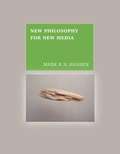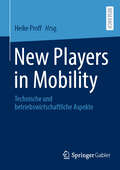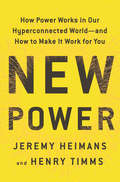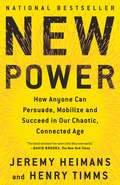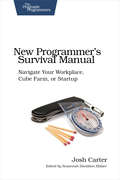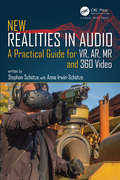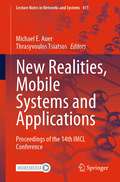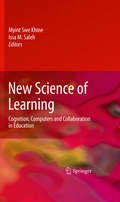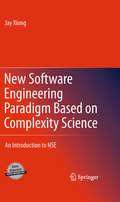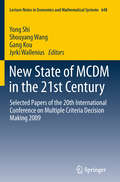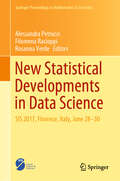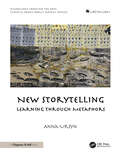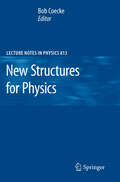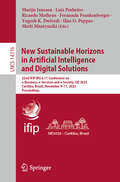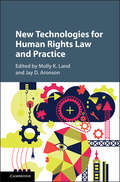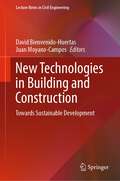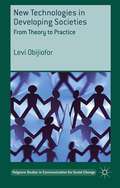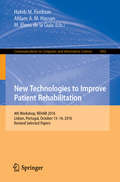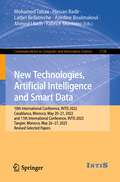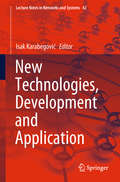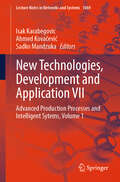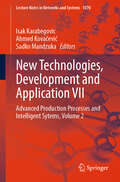- Table View
- List View
New Philosophy for New Media
by Mark B. N. HansenIn New Philosophy for New Media, Mark Hansen defines the image in digital art in terms that go beyond the merely visual. Arguing that the "digital image" encompasses the entire process by which information is made perceivable, he places the body in a privileged position -- as the agent that filters information in order to create images. By doing so, he counters prevailing notions of technological transcendence and argues for the indispensability of the human in the digital era. Hansen examines new media art and theory in light of Henri Bergson's argument that affection and memory render perception impure -- that we select only those images precisely relevant to our singular form of embodiment. Hansen updates this argument for the digital age, arguing that we filter the information we receive to create images rather than simply receiving images as preexisting technical forms. This framing function yields what Hansen calls the "digital image." He argues that this new "embodied" status of the frame corresponds directly to the digital revolution: a digitized image is not a fixed representation of reality, but is defined by its complete flexibility and accessibility. It is not just that the interactivity of new media turns viewers into users; the image itself has become the body's process of perceiving it. To illustrate his account of how the body filters information in order to create images, Hansen focuses on new media artists who follow a "Bergsonist vocation"; through concrete engagement with the work of artists like Jeffrey Shaw, Douglas Gordon, and Bill Viola, Hansen explores the contemporary aesthetic investment in the affective, bodily basis of vision.
New Players in Mobility: Technische und betriebswirtschaftliche Aspekte
by Heike ProffBeim 16. Wissenschaftsforum Mobilität in Duisburg wurde im Juni 2024 über neue Anbieter in der Automobilindustrie und der Mobilitätsbranche diskutiert. Der Tagungsband enthält Beiträge an den Schnittstellen der betriebswirtschaftlichen und der ingenieurwissenschaftlichen Forschung, die dort präsentiert wurden. Dabei werden v.a. folgende Aspekte beleuchtet: New Players in Mobility Management New Players in Mobility Engineering Cities and their inhabitants – Influencing mobility New competition from IT and Asia Addressing and incentivizing customers
New Power: How Power Works in Our Hyperconnected World--and How to Make It Work for You
by Jeremy Heimans Henry TimmsFrom two influential and visionary thinkers comes a big idea that is changing the way movements catch fire and ideas spread in our highly connected world.For the vast majority of human history, power has been held by the few. "Old power" is closed, inaccessible, and leader-driven. Once gained, it is jealously guarded, and the powerful spend it carefully, like currency. But the technological revolution of the past two decades has made possible a new form of power, one that operates differently, like a current. "New power" is made by many; it is open, participatory, often leaderless, and peer-driven. Like water or electricity, it is most forceful when it surges. The goal with new power is not to hoard it, but to channel it. New power is behind the rise of participatory communities like Facebook and YouTube, sharing services like Uber and Airbnb, and rapid-fire social movements like Brexit and #BlackLivesMatter. It explains the unlikely success of Barack Obama's 2008 campaign and the unlikelier victory of Donald Trump in 2016. And it gives ISIS its power to propagate its brand and distribute its violence. Even old power institutions like the Papacy, NASA, and LEGO have tapped into the strength of the crowd to stage improbable reinventions. In New Power, the business leaders/social visionaries Jeremy Heimans and Henry Timms provide the tools for using new power to successfully spread an idea or lead a movement in the twenty-first century. Drawing on examples from business, politics, and social justice, they explain the new world we live in--a world where connectivity has made change shocking and swift and a world in which everyone expects to participate.
New Power: How Power Works in Our Hyperconnected World--and How to Make It Work for You
by Jeremy Heimans Henry TimmsIn this indispensable guide to navigating the twenty-first century, two visionary thinkers reveal the unexpected ways power is changing--and how "new power" is reshaping politics, business, and life.Why do some leap ahead while others fall behind in our chaotic, connected age? In New Power, Jeremy Heimans and Henry Timms confront the biggest stories of our time--the rise of mega-platforms like Facebook and Uber; the out-of-nowhere victories of Obama and Trump; the unexpected emergence of movements like #MeToo--and reveal what's really behind them: the rise of "new power."For most of human history, the rules of power were clear: power was something to be seized and then jealously guarded. This "old power" was out of reach for the vast majority of people. But our ubiquitous connectivity makes possible a different kind of power. "New power" is made by many. It is open, participatory, and peer-driven. It works like a current, not a currency--and it is most forceful when it surges. The battle between old and new power is determining who governs us, how we work, and even how we think and feel. New Power shines fresh light on the cultural phenomena of our day, from #BlackLivesMatter to the Ice Bucket Challenge to Airbnb, uncovering the new power forces that made them huge. Drawing on examples from business, activism, and pop culture, as well as the study of organizations like Lego, NASA, Reddit, and TED, Heimans and Timms explain how to build new power and channel it successfully. They also explore the dark side of these forces: the way ISIS has co-opted new power to monstrous ends, and the rise of the alt-right's "intensity machine."In an era increasingly shaped by new power, this groundbreaking book offers us a new way to understand the world--and our role in it.
New Programmer's Survival Manual: Navigate Your Workplace, Cube Farm, or Startup
by Joshua D. CarterIt's your first day on the new job. You've got the programming chops, you're up on the latest tech, you're sitting at your workstation... now what? New Programmer's Survival Manual gives your career the jolt it needs to get going: essential industry skills to help you apply your raw programming talent and make a name for yourself. It's a no-holds-barred look at what really goes on in the office--and how to not only survive, but thrive in your first job and beyond.Programming at industry level requires new skills - you'll build programs that dwarf anything you've done on your own. This book introduces you to practices for working on large-scale, long-lived programs at a professional level of quality. You'll find out how to work efficiently with your current tools, and discover essential new tools.But the tools are only part of the story; you've got to get street-smart too. Succeeding in the corporate working environment requires its own savvy. You'll learn how to navigate the office, work with your teammates, and how to deal with other people outside of your department. You'll understand where you fit into the big picture and how you contribute to the company's success. You'll also get a candid look at the tougher aspects of the job: stress, conflict, and office politics.Finally, programming is a job you can do for the long haul. This book helps you look ahead to the years to come, and your future opportunities--either as a programmer or in another role you grow into.There's nothing quite like the satisfaction of shipping a product and knowing, "I built that." Whether you work on embedded systems or web-based applications, in trendy technologies or legacy systems, this book helps you get from raw skill to an accomplished professional.
New Realities in Audio: A Practical Guide for VR, AR, MR and 360 Video.
by Stephan Schütze Anna Irwin-SchützeThe new realities are here. Virtual and Augmented realities and 360 video technologies are rapidly entering our homes and office spaces. Good quality audio has always been important to the user experience, but in the new realities, it is more than important, it’s essential. If the audio doesn’t work, the immersion of the experience fails and the cracks in the new reality start to show. This practical guide helps you navigate the challenges and pitfalls of designing audio for these new realities. This technology is different from anything we’ve seen before and requires an entirely new approach; this book will introduce the broad concepts you need to know before delving into the practical detail you need. Key Features This book covers audio for all types of new reality technology. At the moment, VR and 360 video are getting a lot of press, but in a few years we will be hearing a lot more about Augmented and Mixed reality technologies as well. A practical guide to creating, designing and implementing audio for this new technology by a leading sound design and implementation expert. Conceptual explanations address the new approaches necessary to designing effective audio for the new realities. Real-world examples and analysis of what does and does not work including detailed case study discussions.
New Realities, Mobile Systems and Applications: Proceedings of the 14th IMCL Conference (Lecture Notes in Networks and Systems #411)
by Michael E. Auer Thrasyvoulos TsiatsosThis book devotes to new approaches in interactive mobile technologies with a focus on learning. Interactive mobile technologies are today the core of many—if not all—fields of society. Not only the younger generation of students expects a mobile working and learning environment. And nearly daily new ideas, technologies and solutions boost this trend.To discuss and assess the trends in the interactive mobile field are the aims connected with the 14th International Conference on Interactive Mobile Communication, Technologies and Learning (IMCL2021), which was held online from 4 to 5 November 2021.Since its beginning in 2006, this conference is devoted to new approaches in interactive mobile technologies with a focus on learning. Nowadays, the IMCL conferences are a forum of the exchange of new research results and relevant trends as well as the exchange of experiences and examples of good practice. Interested readership includes policy makers, academics, educators, researchers in pedagogy and learning theory, school teachers, learning Industry, further education lecturers, etc.
New Science of Learning
by Myint Swe Khine Issa M. SalehThe earliest educational software simply transferred print material from the page to the monitor. Since then, the Internet and other digital media have brought students an ever-expanding, low-cost knowledge base and the opportunity to interact with minds around the globe--while running the risk of shortening their attention spans, isolating them from interpersonal contact, and subjecting them to information overload. The New Science of Learning: Cognition, Computers and Collaboration in Education deftly explores the multiple relationships found among these critical elements in students' increasingly complex and multi-paced educational experience. Starting with instructors' insights into the cognitive effects of digital media--a diverse range of viewpoints with little consensus--this cutting-edge resource acknowledges the double-edged potential inherent in computer-based education and its role in shaping students' thinking capabilities. Accordingly, the emphasis is on strategies that maximize the strengths and compensate for the negative aspects of digital learning, including: Group cognition as a foundation for learning Metacognitive control of learning and remembering Higher education course development using open education resources Designing a technology-oriented teacher professional development model Supporting student collaboration with digital video tools Teaching and learning through social annotation practices The New Science of Learning: Cognition, Computers and Collaboration in Education brings emerging challenges and innovative ideas into sharp focus for researchers in educational psychology, instructional design, education technologies, and the learning sciences.
New Software Engineering Paradigm Based on Complexity Science
by Jay XiongThis book describes a complete revolution in software engineering based on complexity science through the establishment of NSE - Nonlinear Software Engineering paradigm which complies with the essential principles of complexity science, including the Nonlinearity principle, the Holism principle, the Complexity Arises From Simple Rules principle, the Initial Condition Sensitivity principle, the Sensitivity to Change principle, the Dynamics principle, the Openness principle, the Self-organization principle, and the Self-adaptation principle. The aims of this book are to offer revolutionary solutions to solve the critical problems existing with the old-established software engineering paradigm based on linear thinking and simplistic science complied with the superposition principle, and make it possible tohelp software development organizations double their productivity, halve their cost, and remove 99% to 99.99% of the defects in their software products, and efficiently handle software complexity, conformity, visibility, and changeability. It covers almost all areas in software engineering. The tools NSE_CLICK- an automatic acceptance testing platform for outsourcing (or internally developed) C/C++ products, and NSE_CLICK_J - an automatic acceptance testing platform for outsourcing (or internally developed) Java products are particularly designed for non-technical readers to view/review how the acceptance testing of a software product developed with NSE can be performed automatically, and how the product developed with NSE is truly maintainable at the customer site.
New State of MCDM in the 21st Century
by Yong Shi Gang Kou Shouyang Wang Jyrki WalleniusThis book provides cutting-edge research results and application experiences from researchers and practitioners in multiple criteria decision making areas. It consists of three parts: MCDM Foundation and Theory, MCDM Methodology, and MCDM Applications. In Part I, it covers the historical MCDM development, the influence of MCDM on technology, society and policy, Pareto optimization, and analytical hierarchy process. In Part II, the book presents different MCDM algorithms based on techniques of robust estimating, evolutionary multiobjective optimization, Choquet integrals, and genetic search. In Part III, this book demonstrates a variety of MCDM applications, including project management, financial investment, credit risk analysis, railway transportation, online advertising, transport infrastructure, environmental pollution, chemical industry, and regional economy. The 17 papers of the book have been selected out of the 121 accepted papers at the 20th International Conference on Multiple Criteria Decision Making "New State of MCDM in 21st Century", held at Chengdu, China, in 2009. The 35 contributors of these papers stem from 10 countries.
New State of MCDM in the 21st Century: Selected Papers of the 20th International Conference on Multiple Criteria Decision Making 2009 (Lecture Notes in Economics and Mathematical Systems #648)
by Yong Shi Gang Kou Shouyang Wang Jyrki WalleniusThis book provides cutting-edge research results and application experiences from researchers and practitioners in multiple criteria decision making areas. It consists of three parts: MCDM Foundation and Theory, MCDM Methodology, and MCDM Applications. In Part I, it covers the historical MCDM development, the influence of MCDM on technology, society and policy, Pareto optimization, and analytical hierarchy process. In Part II, the book presents different MCDM algorithms based on techniques of robust estimating, evolutionary multiobjective optimization, Choquet integrals, and genetic search. In Part III, this book demonstrates a variety of MCDM applications, including project management, financial investment, credit risk analysis, railway transportation, online advertising, transport infrastructure, environmental pollution, chemical industry, and regional economy. The 17 papers of the book have been selected out of the 121 accepted papers at the 20th International Conference on Multiple Criteria Decision Making "New State of MCDM in 21st Century", held at Chengdu, China, in 2009. The 35 contributors of these papers stem from 10 countries.
New Statistical Developments in Data Science: SIS 2017, Florence, Italy, June 28-30 (Springer Proceedings in Mathematics & Statistics #288)
by Alessandra Petrucci Filomena Racioppi Rosanna VerdeThis volume collects the extended versions of papers presented at the SIS Conference “Statistics and Data Science: new challenges, new generations”, held in Florence, Italy on June 28-30, 2017. Highlighting the central role of statistics and data analysis methods in the era of Data Science, the contributions offer an essential overview of the latest developments in various areas of statistics research. The 35 contributions have been divided into six parts, each of which focuses on a core area contributing to “Data Science”. The book covers topics including strong statistical methodologies, Bayesian approaches, applications in population and social studies, studies in economics and finance, techniques of sample design and mathematical statistics. Though the book is mainly intended for researchers interested in the latest frontiers of Statistics and Data Analysis, it also offers valuable supplementary material for students of the disciplines dealt with here. Lastly, it will help Statisticians and Data Scientists recognize their counterparts’ fundamental role.
New Storytelling: Learning through Metaphors
by Anna UrsynThere is a global need to become less fearful of coding, as it improves communication with the coders on the job and helps with prompt writing, which hiring companies often request. This set of story-based learning projects links performances and tasks with computing codes to show how a machine translates our goals into its language. Metaphors link instructions telling a computer what task to perform with similar functions in other disciplines. The materials serve those in Computer Graphics, Digital Media, or anyone interested in understanding and becoming familiar with principles and the logic behind coding, and help understand machines when writing a prompt. Dance, music, and performing visually present knowledge through stories and serve as a metaphor for understanding how coding and current technologies affect various disciplines. By introducing basic ideas behind programming in a symbolic way, this book shows how computing and nature overlap through storytelling.Most jobs are collaborative, and coding involves many parts of production processes. These knowledge-based stories improve communication between the artists and the coders to bridge the gap between them.It is a part of the “Knowledge Through the Arts” series, consisting of:Dance Code - Dance Steps as a CodeNew Storytelling - Learning Through MetaphorsCode Appreciation - Reshaping KnowledgeNature Appreciation - Knowledge as Art
New Structures for Physics
by Bob CoeckeThis volume provides a series of tutorials on mathematical structures which recently have gained prominence in physics, ranging from quantum foundations, via quantum information, to quantum gravity. These include the theory of monoidal categories and corresponding graphical calculi, Girard's linear logic, Scott domains, lambda calculus and corresponding logics for typing, topos theory, and more general process structures. Most of these structures are very prominent in computer science; the chapters here are tailored towards an audience of physicists.
New Sustainable Horizons in Artificial Intelligence and Digital Solutions: 22nd IFIP WG 6.11 Conference on e-Business, e-Services and e-Society, I3E 2023, Curitiba, Brazil, November 9–11, 2023, Proceedings (Lecture Notes in Computer Science #14316)
by Yogesh K. Dwivedi Marijn Janssen Matti Mäntymäki Fernanda Frankenberger Ilias O. Pappas Luiz Pinheiro Ricardo MatheusThis book constitutes the refereed proceedings of the 22nd IFIP WG 6.11 Conference on e-Business, e-Services and e-Society, I3E 2023, held in Curitiba, Brazil, during November 9–11, 2023.The 29 full papers and 2 short papers presented in this volume were carefully reviewed and selected from 68 submissions. The contributions were organized in topical sections as follows: Artificial Intelligence and Algorithm; Digital Transformation and New Technologies; and Sustainable Technologies and Smart Cities.
New Technologies for Human Rights Law and Practice
by Jay D. Aronson Molly K. LandNew technological innovations offer significant opportunities to promote and protect human rights. At the same time, they also pose undeniable risks. In some areas, they may even be changing what we mean by human rights. The fact that new technologies are often privately controlled raises further questions about accountability and transparency and the role of human rights in regulating these actors. This volume – edited by Molly K. Land and Jay D. Aronson – provides an essential roadmap for understanding the relationship between technology and human rights law and practice. It offers cutting-edge analysis and practical strategies in contexts as diverse as autonomous lethal weapons, climate change technology, the Internet and social media, and water meters. This title is also available as Open Access.
New Technologies for Literacy and Adult Education: A Global Perspective
by Daniel A. Wagner Robert B. KozmaThis book analyzes two interconnected approaches to using ICT (Information and Communications Technologies) to support adult literacy and adult/basic education.
New Technologies in Building and Construction: Towards Sustainable Development (Lecture Notes in Civil Engineering #258)
by David Bienvenido-Huertas Juan Moyano-CamposThis book presents contributions on new technologies in building and construction. Buildings are complex elements that impact environment significantly. The sustainability of this sector requires a holistic and multidisciplinary approach that allows adequate strategies to be established to reduce its environmental impact. This heterogeneity is represented in these chapters, which have been developed by researchers from different countries. The book is divided into three sections: (i) analysis, (ii) design and modeling, and (iii) solutions. The book chapters together represent an advance in current knowledge about new technologies in building and construction, crucial for researchers, engineers, architects, policy makers, and stakeholders.
New Technologies in Developing Societies
by Levi ObijioforNew Technologies in Developing Societies examines critically, and from theoretical, practical and policy perspectives how new technologies are transforming day-to-day human activities in Africa and other developing regions. In particular it addresses how technologies are harnessed to enhance socioeconomic conditions, and how people use technologies to empower themselves and to foster a strong deliberative democracy. It also studies how they deal with the challenges that new technologies pose to the protection of intellectual property rights of indigenous people, and the struggles between tradition and modernity in the HIV/AIDS prevention campaign.
New Technologies to Improve Patient Rehabilitation: 4th Workshop, REHAB 2016, Lisbon, Portugal, October 13-14, 2016, Revised Selected Papers (Communications in Computer and Information Science #1002)
by Habib M. Fardoun Ahlam A. Hassan M. Elena de la GuíaThis book constitutes the thoroughly refereed proceedings of the 4th International Workshop on ICTs for Improving Patients Rehabilitation Research Techniques, REHAB 2016, held in Lisbon, Portugal, in October 2016.The 10 revised full papers presented were carefully reviewed and selected from 33 submissions. The papers explore how technology can contribute toward smarter and effective rehabilitation methods.
New Technologies, Artificial Intelligence and Smart Data: 10th International Conference, INTIS 2022, Casablanca, Morocco, May 20–21, 2022, and 11th International Conference, INTIS 2023, Tangier, Morocco, May 26–27, 2023, Revised Selected Papers (Communications in Computer and Information Science #1728)
by Ladjel Bellatreche Azedine Boulmakoul Mohamed Tabaa Hassan Badir Ahmed Lbath Fabrice MonteiroThis volume constitutes selected papers presented at the 10th International Conference on Innovation and New Trends in Information Technology, INTIS 2022, held in Casablanca, Morocco, in May 2022, and 11th International Conference on Innovation and New Trends in Information Technology, INTIS 2023, held in Tangier, Morocco, in May 2023.After the thorough peer review process, 4 papers were selected from the 27 submissions received for INTIS 2022, and 11 papers were selected from the 33 submissions received for INTIS 2023. The presented papers cover the mail topics of data-enabled systems/applications: data source layer, network layer, data layer, learning layer, and reporting layers while considering non-functional properties such as data privacy, security, and ethics.
New Technologies, Development and Application (Lecture Notes in Networks and Systems #42)
by Isak KarabegovićThe papers included in this book were presented at the International Conference “New Technologies, Development and Application,” which was held at the Academy of Sciences and Arts of Bosnia and Herzegovina in Sarajevo, Bosnia and Herzegovina on 28th–30th June 2018. The book covers a wide range of technologies and technical disciplines including complex systems such as: Robotics, Mechatronics Systems, Automation, Manufacturing, Cyber-Physical Systems, Autonomous Systems, Sensors, Networks, Control Systems, Energy Systems, Automotive Systems, Biological Systems, Vehicular Networking and Connected Vehicles, Effectiveness and Logistics Systems, Smart Grids, Nonlinear Systems, Power Systems, Social Systems, and Economic Systems.
New Technologies, Development and Application VII: Advanced Production Processes and Intelligent Sytems, Volume 1 (Lecture Notes in Networks and Systems #1069)
by Ahmed Kovačević Isak Karabegovic Sadko MandzukaThis book features papers focusing on the implementation of new and future technologies, which were presented at the International Conference on New Technologies, Development and Application—Advanced Production Processes and Intelligent Systems held at the Academy of Science and Arts of Bosnia and Herzegovina in Sarajevo on 20–22 June 2024. It covers a wide range of future technologies and technical disciplines, including complex systems such as Industry 4.0; robotics; mechatronics systems; automation; manufacturing; cyber-physical and autonomous systems; sensors; networks; control, energy, renewable energy sources; automotive and biological systems; vehicular networking and connected vehicles; and intelligent transport, effectiveness and logistics systems, smart grids, nonlinear systems, power, social and economic systems, education, and IoT. The book New Technologies, Development and Application VII is oriented toward Fourth Industrial Revolution “Industry 4.0”, which implementation will improve many aspects of human life in all segments and lead to changes in business paradigms and production models. Further, new business methods are emerging, transforming production systems, transport, delivery, and consumption, which need to be monitored and implemented by every company involved in the global market.
New Technologies, Development and Application VII: Advanced Production Processes and Intelligent Sytems, Volume 2 (Lecture Notes in Networks and Systems #1070)
by Ahmed Kovačević Isak Karabegovic Sadko MandzukaThis book features papers focusing on the implementation of new and future technologies, which were presented at the International Conference on New Technologies, Development and Application—Advanced Production Processes and Intelligent Systems held at the Academy of Science and Arts of Bosnia and Herzegovina in Sarajevo on 20–22 June 2024. It covers a wide range of future technologies and technical disciplines, including complex systems such as Industry 4.0; robotics; mechatronics systems; automation; manufacturing; cyber-physical and autonomous systems; sensors; networks; control, energy, renewable energy sources; automotive and biological systems; vehicular networking and connected vehicles; and intelligent transport, effectiveness and logistics systems, smart grids, nonlinear systems, power, social and economic systems, education, and IoT. The book New Technologies, Development and Application VII is oriented toward Fourth Industrial Revolution “Industry 4.0”, which implementation will improve many aspects of human life in all segments and lead to changes in business paradigms and production models. Further, new business methods are emerging, transforming production systems, transport, delivery, and consumption, which need to be monitored and implemented by every company involved in the global market.
New Technologies, Development and Application VIII: Volume 1 (Lecture Notes in Networks and Systems #1482)
by Isak Karabegović Ahmed Kovačević Sadko MandžukaThis book provides a comprehensive overview of the latest technological achievements, their development and practical applications in various industries. In a world that is constantly changing, technology is the driving force behind progress. This book contains papers focusing on the implementation of new and future technologies, which were presented at the International Conference on New Technologies, Development and Application—Advanced Manufacturing Processes and Intelligent Systems, held at the Academy of Sciences and Arts of Bosnia and Herzegovina in Sarajevo from 26 to 28 June 2025. Through clear and concise analyses, the authors explore key innovations such as robotics, artificial intelligence, internet of things, blockchain, biotechnology and sustainable solutions. Furthermore, new business methods are emerging that are transforming production systems, transportation, delivery and consumption, which every company involved in the global market should monitor and implement. The book offers in-depth insight into how these technologies are transforming business, education, health care and everyday life. Whether you're a professional looking to stay up to date with the latest trends, a student exploring future career opportunities, or an enthusiast interested in technological change, this book provides useful information and practical, real-world examples. Don't let the future surprise you—find out how new technologies are shaping the world and how you can apply them today.
